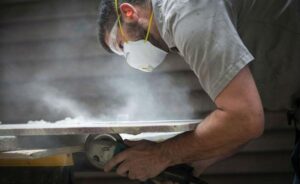Are you compliant with OSHA’s updated Respirable Crystalline Silica Standard?
Companies have until June 23, 2018 to comply with the Methods of sample analysis
Each year, nearly 2.3 million of America’s workers are exposed to crystalline silica, a mineral found in mortar, concrete, sand and stone. Exposure occurs when workers cut, grind, crush, or drill silica-containing materials and has been linked to lung cancer and kidney disease, among other conditions.
After challenges from various industry groups, the Occupational Safety and Health Administration (OSHA) issued a new The Respirable Crystalline Silica Standard in June of 2016 decreasing the Permissible Exposure Limits (PELs) related to silica. The new PEL is 50 micrograms per cubic meter of air averaged over an 8-hour shift – 50% less than the previous limit.
The change comes after it was determined that the previous PELs were inconsistent, difficult to understand, outdated (they were based on research from the 1960s) and did not adequately protect workers.
The Respirable Crystalline Silica Standard has distinct deadlines to comply with worker exposure controls and medical examinations depending on industry (general/maritime industries and construction are considered separately).
However, June 23, 2018, is the deadline for all industries to comply with the required Methods of sample analysis (Appendix A to § 1926.1153).
Methods of Sample Analysis Compliance
In order to provide consistent measurements, employers are required to use qualified labs to analyze the silica samples. Employers must now ensure that the laboratories meet the following standards*:
-
Evaluates all samples using the procedures specified in one of the following analytical methods: OSHA ID-142 (XRD); NMAM 7500 (XRD); NMAM 7602 (IR); NMAM 7603 (IR); MSHA P-2 (XRD); or MSHA P-7 (IR);
-
Is accredited to ANS/ISO/IEC Standard 17025:2005 with respect to crystalline silica analyses by a body that is compliant with ISO/IEC Standard 17011:2004 for implementation of quality assessment programs;
-
Uses the most current National Institute of Standards and Technology (NIST) or NIST traceable standards for instrument calibration or instrument calibration verification;
-
Implements an internal quality control (QC) program that evaluates analytical uncertainty and provides employers with estimates of sampling and analytical error;
-
Characterizes the sample material by identifying polymorphs of respirable crystalline silica present, identifies the presence of any interfering compounds that might affect the analysis, and makes any corrections necessary in order to obtain accurate sample analysis; and (important for IR method)
-
Analyzes quantitatively for crystalline silica only after confirming that the sample matrix is free of uncorrectable analytical interferences, corrects for analytical interferences, and uses a method that meets the following performance specifications:
6.1 Each day that samples are analyzed, performs instrument calibration checks with standards that bracket the sample concentrations;
6.2 Uses five or more calibration standard levels to prepare calibration curves and ensures that standards are distributed through the calibration range in a manner that accurately reflects the underlying calibration curve; and
6.3 Optimizes methods and instruments to obtain a quantitative limit of detection that represents a value no higher than 25 percent of the PEL based on sample air volume.
“Laboratories use x-ray diffraction (XRD) to determine the species and mass of silica present on samples taken,” said Jon Balsamo, Manager of Industrial Hygiene Services. “X-ray diffraction is considered the industry standard and the most accurate method for determining silica content.”
Penalties
Fines for non-compliance to the new standard include a maximum of $12,934 for a serious or other-than-serious violation, $12,934 per day past the abatement date for a failure-to-abate violation and $129,336 for a repeated or willful violation.
Help with Compliance
In order to help all businesses comply with this change, OSHA offers an On-Site Consultation program at no cost, as well as publications, webinars and training. PM Environmental can provide the onsite testing during work activities and submit samples to a qualified laboratory on behalf of the contractor to determine what exposures are present to workers.
“PM is committed to working with our clients to provide a safe and healthy work environment,” said Balsamo. “We can provide onsite sample collection and review laboratory data and provide recommendations as necessary to achieve these new OSHA regulations.”

More information is available at https://www.osha.gov/dsg/topics/silicacrystalline/
or at: https://www.silica-safe.org/
* https://www.osha.gov/silica/AppendixAtosect1926.1153.pdf
News Details
Date
February 20, 2018

